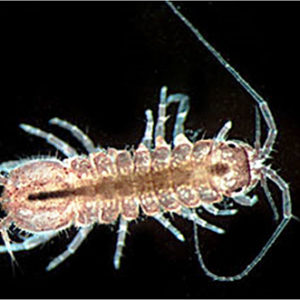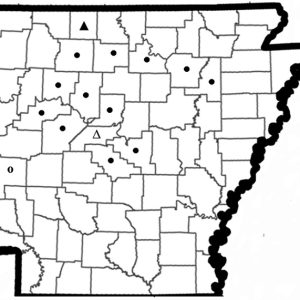calsfoundation@cals.org
Endemic Isopods
Isopods belong to the Phylum Arthropoda, Subphylum Crustacea, Class Malacostraca, and Order Isopoda, and include pillbugs, sowbugs, woodlice, and their relatives. Isopods are cosmopolitan organisms that inhabit saltwater and freshwater habitats, including subterranean waters, but they can also be found in terrestrial environments. There are over 10,000 species of isopods worldwide in eleven suborders with about 4,500 species found in marine environments, 500 species in freshwater environments, and 5,000 species on land. Their fossil record dates back to the Carboniferous Period of the Paleozoic (some 300 million years ago) when they lived in shallow seas. Isopods range in length from thirty micrometers (microcerberid isopods) to 500 mm (19.7 in.) for the giant Antarctic isopod (Bathynomus giganteus). The majority of North American freshwater isopods belong to the family Asellidae, which includes two important genera: Caecidotea and Lirceus. Of the thirty-three species found in Arkansas, four are endemic in the state.
The marine species are known from all the world’s oceans, living mostly on the sea bottom from the lowermost depths to the intertidal zone, with only a few pelagic representatives. Isopods have also successfully colonized a variety of freshwater habitats, including lakes, rivers, streams, underground waters, geothermal springs, water found in certain tropical plants, and anchialine/cave habitats, where they often display subterranean morphological adaptations (lacking pigmentation and eyes, for example). Fully terrestrial members (sowbugs and pillbugs) are by far the most successful group of crustaceans to invade land.
All isopods are dorsoventrally flattened and have rigid, segmented exoskeletons; sessile eyes (when present); two pairs of antennae; and seven pairs of jointed limbs on their thorax (walking legs), each bearing a pair of unbranched pereopods (limbs). Since isopods lack a carapace and true gills, respiration is accomplished using specialized lamellar gill-like pleopods (“swimming limbs”) on the posterior section of the body. Unlike all other crustaceans, isopods shed their cuticle (a process called ecdysis) in two steps (biphasic molting).
In most species, the sexes are separate, but a few species are hermaphroditic. Males have a pair of penises, which may be fused in some species. The sperm is transferred to the female by the modified second pleopod, which receives it from the penis and which is then inserted into a female gonopore. Fertilization takes place only when the eggs (which may number in the hundreds) are shed soon after a molt. Females brood their young in a special chamber (marsupium) under their thorax.
Isopods display a variety of feeding methods. Some species eat dead or decaying plant and animal matter, while several others are grazers, browsers, or filter feeders. A few are scavengers and predaceous carnivores, while some have even adapted into a parasitic lifestyle as internal or external parasites, mostly in or on fishes. They can harm, or even kill, their hosts, which can cause significant economic losses to commercial fishery.
In Arkansas, there are thirty-three species of isopods found within the families Armadillidiidae, Armadillidae, Asellidae, Cylisticidae, Ligiidae, Oniscidae, Porcellionidae, Trachelipodidae, and Trichoniscidae. Two genera, Caecidotea and Lirceus, comprise the majority of species in the state, with eighteen and six taxa, respectively. Of the thirty-three species found in Arkansas, only four (twelve percent) are endemic in the state. They all belong in the family Asellidae and are as follows: Caecidotea fonticulus, Caecidotea holti, Lirceus bicuspidatus, and Lirceus bidentatus.
The endemic Abernathy Spring isopod (C. fonticulus) was described by Julian Lewis in 1983 from specimens first collected in 1979 by Henry W. Robison from Abernathy Spring in Polk County. This spring flows from a stainless-steel conduct sunk lengthwise into the ground, and after a few meters, the spring joins another stream, Big Fork Creek. This isopod is the first phreatobite (a troglomorphic species restricted to the phreatic zone) from the Ouachita Mountains province. Morphologically, C. fonticulus is eyeless and unpigmented, and specimens measure five to six mm (0.20 to 0.23 in.) long. It is listed as a critically imperiled (S1) species in the state according to NatureServe.
Caecidotea holti (no common name—NCN) was collected by Leslie Hubricht in 1940 and described by L. E. Fleming in 1972 from a small stream 2.4 km (1.8 miles) east of Casa in Perry County. It is a moderately sized, pigmented isopod with reduced eyes. The holotype measures 7.2 mm (0.28 in) long and 1.6 mm (0.06 in) wide. It is known only from the type locality and is listed as an S1 species in the state according to NatureServe.
Lirceus bicuspidatus (NCN) was described by L. Hubricht and J. G. Mackin in 1949 from a spring on a small stream flowing behind the College Chapel at Clarksville in Johnson County. It is a widely ranging species that has also been found in other sites in twelve counties in the Boston and Ouachita Mountains as follows: a small stream at Petit Jean State Park in Conway County; Foushee Cave in Independence County; a small stream on a hillside, 2.4 km (1.5 mi.) southeast of Olyphant in Jackson County; a creek in Kings Canyon, 8.0 km (5.0 mi.) north of Clarksville and a spring near Lee’s Tavern, 3.2 km (2.0 mi.) northeast of Clarksville in Johnson County; a stream on the side of Mount Magazine, 4.2 km (2.6 mi.) southeast of Corley, and a spring on Shelf Road of Mount Nebo, Mount Nebo State Park in Logan County; small seeps, 6.4 km (4.0 mi.) south of Boxley, a small stream, 15.4 km (9.6 mi.) south of Boxley, and a spring below Diamond Cave in Newton County; a temporary stream, 3.2 km (2.0 mi.) southeast of London in Pope County; a small stream, 4.8 km (3.0 mi.) northeast of North Little Rock in Pulaski County; a seep, 8.0 km (5.0 mi.) north of Paron in Saline County; a spring at the mouth of Hurricane River Cave in Searcy County; Hell Creek Cave in Stone County; and a stream, 4.2 km (2.6 mi.) southeast of Ola in Yell County. This isopod is listed as a Species of Greatest Conservation Need by the Arkansas Game and Fish Commission. It is expected that this isopod may eventually be removed from the state list of endemic isopods, given that it has such a wide distribution and could be found just over the border in adjacent states.
Lirceus bidentatus (NCN) was described by L. Hubricht and J. G. Mackin in 1949 from a seep in the Boston Mountains, 14.5 km (9 mi.) southwest of Harrison in Boone County. It is a medium-sized isopod with light gray pigment and a size of up to 14 mm (0.6 in.) in length and 4.5 mm (0.18 in.) in width. This species has been found only at the type locality and is listed as an S1 species in the state according to NatureServe.
With additional field research, more endemic isopods are likely to be discovered and subsequently described from Arkansas. In addition, incorporation of molecular techniques should also allow description of closely related morphological forms that are yet to be documented.
For additional information:
Allen, Robert T. “Additions to the Known Endemic Flora and Fauna of Arkansas.” Proceedings of the Arkansas Academy of Science 42 (1988): 18–21. Online at http://scholarworks.uark.edu/jaas/vol42/iss1/8/ (accessed December 10, 2018).
Arkansas Endangered, Threatened, Regulated, and Species of Greatest Conservation Need. Little Rock: Arkansas Game and Fish Commission, 2016.
Brusca, R. C., and G. D. F. Wilson. “A Phylogenetic Analysis of the Isopoda with Some Classificatory Recommendations.” Memoirs of the Queensland Museum 31 (1991): 143‒204.
Causey, David. “The Terrestrial Isopoda of Arkansas.” Proceedings of the Arkansas Academy of Science 5 (1952): 25–30. Online at http://scholarworks.uark.edu/jaas/vol5/iss1/7/ (accessed December 10, 2018).
Causey, David. “Additional Records of Terrestrial Isopods in Arkansas.” Proceedings of the Arkansas Academy of Science 6 (1953): 49–50. Online at http://scholarworks.uark.edu/jaas/vol6/iss1/14/ (accessed December 10, 2018).
Fenolio, Danté B. Life in the Dark: Illuminating Biodiversity in the Shadowy Haunts of Planet Earth. Baltimore: Johns Hopkins University Press, 2016.
Fleming, Laurence E. “The Evolution of the Eastern North American Isopods of the Genus Asellus (Crustacea: Asellidae) Part I.” International Journal of Speleology 4 (1972): 221‒256.
Graening, G. O., Danté B. Fenolio, and Michael E. Slay. Cave Life of Oklahoma and Arkansas: Exploration and Conservation of Subterranean Biodiversity. Norman: University of Oklahoma Press, 2011.
Graening, G. O., Michael E. Slay, Danté B. Fenolio, and Henry W. Robison. “Annotated Checklist of the Isopoda (Subphylum Crustacea: Class Malacostraca) of Arkansas and Oklahoma, With Emphasis Upon Subterranean Habitats.” Proceedings of the Oklahoma Academy of Science 87 (2007): 1‒14.
Hubricht, Leslie, and J. G. Mackin. “The Freshwater Isopods of the Genus Lirceus (Asellota, Asellidae).” American Midland Naturalist 43 (1949): 332‒349.
Kensley, B., and R. C. Brusca, eds. Isopod Systematics and Evolution. Rotterdam: Balkema, 2001.
Lewis, Julian J. “Caecidotea fonticulus, the First Troglobitic Asellid From the Ouachita Mountains (Crustacea: Isopoda: Asellidae).” Proceedings of the Biological Society of Washington 96 (1983): 149‒153.
Martin, Joel W., and George E. Davis. An Updated Classification of the Recent Crustacea. Los Angeles: Natural History Museum of Los Angeles County, 2001.
McAllister, Chris T., Henry W. Robison, and Michael E. Slay. “The Arkansas Endemic Fauna: An Update with Additions, Deletions, a Synthesis of New Distributional Records, and Changes in Nomenclature.” Texas Journal of Science 61 (2009): 203–218.
McDaniel, Van R., and Kenneth L. Smith. “Cave Fauna of Arkansas: Selected Invertebrate and Vertebrate Taxa.” Proceedings of the Arkansas Academy of Science 30 (1976): 57‒60. Online at http://scholarworks.uark.edu/jaas/vol30/iss1/22 (accessed December 10, 2018).
Robison, Henry W., and Robert T. Allen. Only in Arkansas: A Study of the Endemic Plants and Animals of the State. Fayetteville: University of Arkansas Press, 1995.
Robison, Henry W., and Chris T. McAllister. “The Arkansas Endemic Flora and Fauna: An Update with 13 Additional Species.” Journal of the Arkansas Academy of Science 69 (2015): 78–82. Online at http://scholarworks.uark.edu/jaas/vol69/iss1/16/ (accessed December 10, 2018).
Robison, Henry, Chris McAllister, Christopher Carlton, and Robert Tucker. “The Arkansas Endemic Biota: With Additions and Deletions.” Journal of the Arkansas Academy of Science 62 (2008): 84–96. Online at http://scholarworks.uark.edu/jaas/vol62/iss1/14/ (accessed December 10, 2018).
Robison, Henry W., and Kenneth L. Smith. “The Endemic Flora and Fauna of Arkansas.” Proceedings of the Arkansas Academy of Science 36 (1982): 52–57. Online at http://scholarworks.uark.edu/jaas/vol36/iss1/17/ (accessed December 10, 2018).
Smith, K. The Status of Cambarus zophonastes Hobbs and Bedinger, An Endemic Cave Crayfish from Arkansas. Little Rock: Arkansas Natural Heritage Commission, 1984.
Williams, W. D. “Freshwater Isopods (Asellidae) of North America.” Biota of Freshwater Ecosystems Identification Manual 7 (1972): 1–45.
Youngsteadt, Norman, and Jean Youngsteadt. “Biosurvey of Invertebrates in Foushee Cave, IN-371, With Notes on Vertebrate Observations.” The Association for Arkansas Cave Studies. Harding University, Searcy, Arkansas. AACtivitieS 84 (1978): 12‒15.
Chris T. McAllister
Eastern Oklahoma State College
 Science and Technology
Science and Technology Freshwater Isopods
Freshwater Isopods  Isopods Distribution
Isopods Distribution 




Comments
No comments on this entry yet.